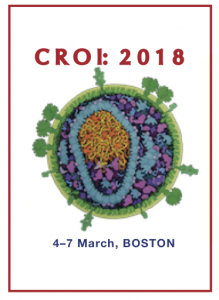Switch to TAF appears safe and effective in adolescents: similar PK to adults
16 April 2018. Related: Conference reports, Paediatric care, CROI 25 (Retrovirus) 2018.
 Polly Clayden, HIV i-Base
Polly Clayden, HIV i-Base
Pharmacokinetics, safety and efficacy of tenofovir alafenamide (TAF) in adolescents receiving the coformulation with emtricitabine (FTC/TAF) was similar to adults at 24 weeks, according to data presented at CROI 2018. [1]
Coformulated FTC/TAF is approved for adolescents aged 12 to 18 years in the US and EU and is a recommended first-line NRTI backbone for adolescents in the US.
FTC/TAF was developed with two versions: 200/10 mg and 200/25 mg for administration with boosted and unboosted agents respectively. FTC/TAF 200/25 mg is the only dose strength approved by the FDA.
Safety and efficacy of TAF in adolescents has been shown in studies of elvitegravir/cobicistat/FTC/TAF and bictegravir/FTC/TAF. Safety, pharmacokinetics (PK), and efficacy of other FTC/TAF-containing regimens in adolescents have not been reported. These data are the first to be presented on FTC/TAF with other with non-Gilead third agents in HIV positive adolescents.
This was a phase 2/3, open-label, multicentre, single arm switching study in 28 virologically suppressed adolescents aged 12 to 18 years weighing at least 35 kg.
Participants were a median age 14 years (range: 12 to 17) and weight 45 kg (range: 35 to 62): 57% male and 43% black. Median CD4 count was 909 cells/mm3. Third agent was efavirenz or lopinavir/ritonavir.
Exposures of TAF and TFV were consistent with those of adults regardless of third agent.
Most common adverse event (AE) was viral upper respiratory infection (32%) followed by headache (25%). Two participants had serious, unrelated AEs. Five had TAF-related AEs; no participant discontinued study drug due to an AE.
Mean % change from baseline in BMD at week 24 was +3.56% for spine and +1.57% for total body less head (TBLH). Mean change in BMD height-age adjusted z-score was 0.00 for spine and –0.03 for TBLH. Mean (SD) estimated change in glomerular filtration rate was 2.0 (20.95) mL/min/1.73 m2.
The majority of participants (92.9%, 26/28) maintained viral load <50 copies/mL. Mean reductions in CD4 count and CD4% from baseline were –130 cells/mm3 and –0.2%.
comment
CROI 2018 also showed the first data from the fixed dose combination of bictegravir/FTC/TAF in 24 virologically suppressed adolescents. [2]
At week 24 PK, safety and efficacy of all the component agents were also similar to those reported in phase 3 trials in adults.
There were no grade 3/4 AEs. One participant experienced grade 1 vomiting, judged related to study drug that resolved on the same day with no adjustment to the regimen.
This fixed dose combination is a considerably smaller tablet than those currently most commonly prescribed (as will generic versions of dolutegravir/FTC/TAF for low- and middle-income countries) – its shape and size were reported to be acceptable.
References
- Chen J et al. Safety, PK, & efficacy of FTC/TAF in HIV-infected adolescents (12–18 yrs). 25th Conference on Retroviruses and Opportunistic Infections (CROI 2018), 4–7 March 2018, Boston. Poster abstract 843.
http://www.croiconference.org/sessions/safety-pk-efficacy-ftctaf-hiv-infected- adolescents-12-18-yrs (abstract and poster) - Guar A et al. Bictegravir/FTC/TAF single-tablet-regimen in adolescents: week 24 results. 25th Conference on Retroviruses and Opportunistic Infections (CROI 2018), 4–7 March 2018, Boston. Poster abstract 844.
http://www.croiconference.org/sessions/bictegravirftctaf-single-tablet-regimen-adolescents-week-24-results (Poster and abstract)

